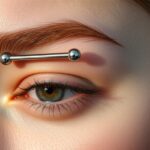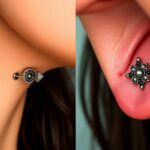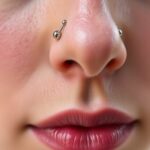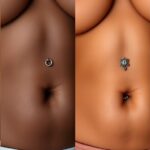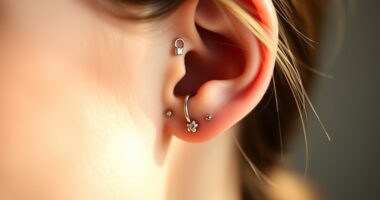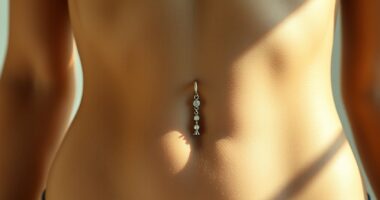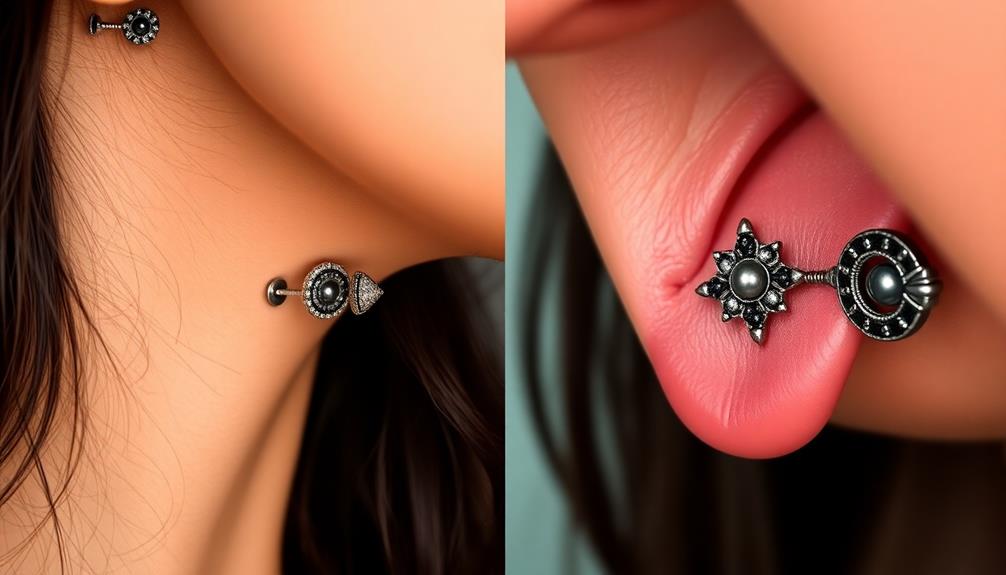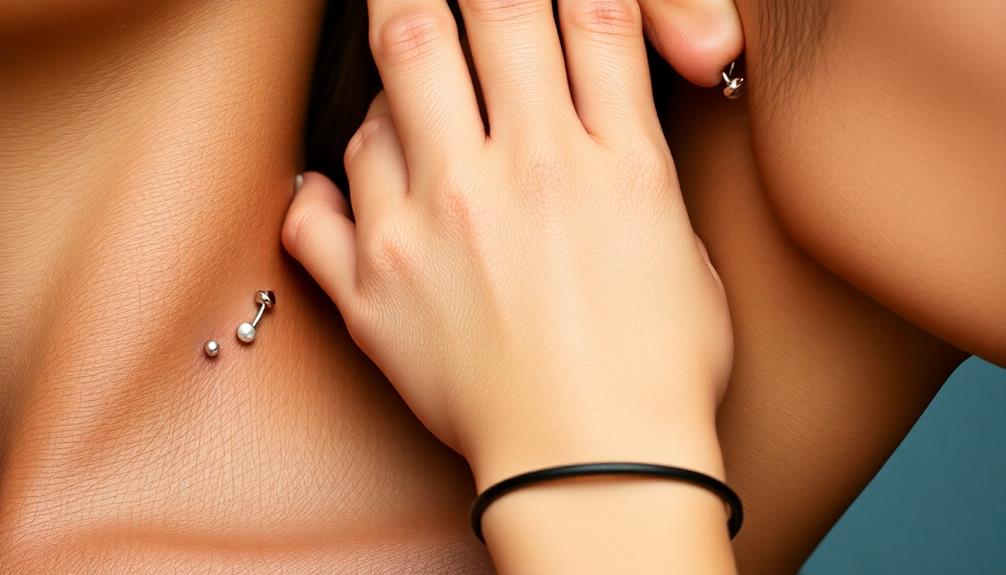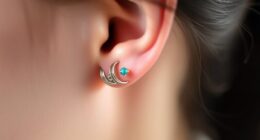Eyebrow piercings come in various placements, enhancing your unique facial features. You can choose vertical or horizontal piercings, or even go for a bridge or anti-eyebrow placement. Each option complements different face shapes and aesthetics. When selecting placement, consider your anatomy and the impact on your overall look. Healing times vary but typically last six to eight weeks, with proper care essential to avoid complications. High-quality jewelry materials like gold or titanium are recommended for comfort and style. There's a lot more to discover about these piercings and how they can fit your individual flair.
Key Takeaways
- Vertical eyebrow piercings elongate the face, while horizontal piercings enhance the brow line for a modern aesthetic.
- Anti-eyebrow piercings highlight the cheekbone, providing a unique flair, but require caution due to nearby capillaries.
- Anatomical assessment is crucial for determining suitable piercing placements and ensuring facial feature complementarity.
- Centered eyebrow piercings have a higher risk of irritation bumps due to eyelid pressure and should be approached with care.
- Quality jewelry, such as titanium or gold, is essential to prevent complications and enhance overall aesthetic appeal.
Types of Eyebrow Piercings

Eyebrow piercings come in several exciting styles, each offering a unique look. The standard vertical eyebrow piercing is one of the most popular choices, typically placed toward the outer third of the brow.
If you're looking for something different, consider horizontal eyebrow piercings, which are often surface piercings located above, below, or even within the brow.
Bridge piercings, also known as mid-brow piercings, require careful anatomical consideration to avoid rejection, as they should be placed perpendicular to the tissue for the best results.
If you want a bolder option, anti-eyebrow piercings sit below the eye on the cheekbone, providing a striking aesthetic, but you'll need to be cautious to avoid nearby capillaries.
Each type of eyebrow piercing has specific jewelry options tailored to its placement. For instance, curved barbells are often recommended for vertical eyebrow piercings, while surface bars work well for horizontal piercings to minimize rejection risks.
Whatever style you choose, understanding these variations can help you achieve the perfect look that complements your facial features.
Placement Considerations

When deciding on your eyebrow piercing placement, you'll want to assess your unique anatomy to guarantee it's suitable.
The aesthetic impact of your choice can greatly affect your overall look, so consider how it complements your features.
Additionally, keep in mind the healing considerations and potential risks associated with different placements to guarantee a smooth recovery.
Anatomical Suitability Assessment
For ideal eyebrow piercing placement, evaluating your anatomical features is fundamental. The presence of sufficient tissue and protrusion is essential for supporting the jewelry and guaranteeing a successful healing process.
Standard placements typically lie toward the outer edge of the brow, angled slightly toward the eye, and perpendicular to the eyebrow for both aesthetic appeal and comfort.
If you're assigned female at birth, you might face challenges due to anatomical differences, but many still have suitable structures for piercing. Centered eyebrow piercings require careful anatomical assessment because they demand more protrusion and can lead to irritation bumps from eyelid pressure.
As a result, consulting a professional piercer is critical to confirm your piercing placement aligns with your ideal anatomy.
Also, remember eyebrow asymmetry is common, so use your pupils as a guideline for a balanced look. By understanding your facial compatibility with various placements, you can set realistic expectations and make informed decisions about your eyebrow piercing.
Ultimately, a thorough evaluation will help you achieve a piercing that not only looks great but also heals well.
Placement Aesthetic Impact
The placement of your eyebrow piercing plays an essential role in enhancing your overall facial aesthetics. Choosing the right spot can truly complement your facial anatomy and influence how others perceive you. Here are some key considerations to keep in mind:
- Standard vertical eyebrow piercings are typically positioned toward the outer third for ideal aesthetic appeal.
- Horizontal eyebrow piercings can be tricky; they should be tested in front of a mirror to find the best angle.
- Mid-brow piercings must be placed perpendicularly to the tissue to avoid issues like rejection or migration.
- Anti-eyebrow piercings offer flexibility but require careful placement to prevent damaging nearby capillaries.
- Remember, the placement can affect your facial expressions, potentially leading to misinterpretations of your emotions.
Ultimately, each type of piercing placement has its unique aesthetic impact.
By considering your facial shape and the relationship between the piercing and your natural features, you can achieve a look that resonates with your personal style while enhancing your overall appearance.
Make sure to think carefully about where you want that piercing to go!
Healing Considerations and Risks
Healing after an eyebrow piercing requires careful attention to placement and aftercare. Centered eyebrow piercings can be more prone to irritation bumps due to pressure from the eyelid and the jewelry, making an anatomical assessment essential for successful placement. Additionally, risks of migration and rejection are higher with centered piercings, so take these factors into account.
| Consideration | Details |
|---|---|
| Irritation | Pressure from eyelids and jewelry can cause bumps. |
| Migration | Centered placements have a higher risk of movement. |
| Rejection | Traditional placements face lower rejection rates. |
| Aftercare | Diligent care is critical to minimize moisture-related issues. |
| Jewelry Quality | Always choose high-quality jewelry to prevent complications. |
Regular check-ins with a professional piercer during the healing process can help you address any signs of irritation or complications related to your specific placement. By being proactive about aftercare and monitoring any changes, you can guarantee a smoother healing journey and reduce risks associated with your new eyebrow piercing.
Healing Process Overview

When you get an eyebrow piercing, understanding the healing process is vital for a successful outcome. The healing duration typically ranges from 6 to 8 weeks, but some may experience a healing time of up to a year based on individual factors.
During the initial healing phase, you might notice some bruising that looks like a subtle black eye; don't worry, this is normal and should fade within a few days.
To guarantee proper healing, keep these tips in mind:
- Regular cleaning with saline solution is essential.
- Avoid contact with hair products and makeup to prevent irritation.
- Monitor for signs of infection, such as redness or swelling.
- Be aware of potential piercing rejection.
- Schedule regular follow-ups with your professional piercer.
If you're a side sleeper or lead an active lifestyle, take extra care to minimize irritation, as this can prolong your healing time.
Following these guidelines will help you navigate the healing process more smoothly and guarantee your piercing looks great!
Jewelry Options

After your eyebrow piercing has healed, choosing the right jewelry becomes a key aspect of enhancing your look and guaranteeing ongoing comfort.
For vertical eyebrow piercings, a curved barbell is your best bet, as it promotes healing and comfort. If you've opted for a horizontal or anti-eyebrow piercing, surface bars are recommended to minimize rejection risks.
For bridge piercings, straight barbells made from titanium offer both style and tissue support, while curved barbells might compromise that essential support.
It's best to steer clear of hoops for fresh piercings, as they can snag and lead to migration, complicating the healing process.
Quality matters; gold or platinum jewelry is durable and less likely to irritate your skin. Avoid gold-plated options, since they can cause irritation over time.
Once your piercing is fully healed, you can explore decorative jewelry pieces, like small gemstones, to personalize your look. Just guarantee these additions don't interfere with the integrity of the piercing or its healing.
Choosing the right jewelry not only enhances your appearance but also supports the longevity of your piercings.
Risks and Complications

Steering through the world of eyebrow piercings involves understanding the risks and complications that can arise. Here are some key points to reflect on:
- Higher risk of migration and rejection due to surface piercing nature
- Individual anatomy impacts healing and complications
- Jewelry choice affects irritation bumps and discomfort
- Lifestyle can increase complication likelihood
- Healing times can vary greatly
Eyebrow piercings, as surface piercings, face a greater chance of migration and rejection when compared to other facial piercings.
Factors such as your individual anatomy, jewelry choice, and lifestyle can greatly impact the healing process. If you're an active person or tend to sleep on your side, you might experience complications more frequently.
Common issues include irritation bumps caused by snagging, improper jewelry, or pressure from the eyelid.
Healing typically takes 6 to 8 weeks, but some placements might require longer. During this time, proper aftercare is essential to monitor for signs of irritation or infection.
If rejection occurs, promptly removing the jewelry can prevent more serious complications. Regular check-ins with your piercer can help address any concerns early on.
Aesthetic Impact and Trends

Eyebrow piercings often enhance personal style and can dramatically alter your facial expression and symmetry. The aesthetic impact of these piercings depends greatly on their placement options and how they interact with your natural anatomy. As trends in piercing evolve, more unique and nontraditional styles are becoming popular, allowing for greater personal expression.
Here's a quick overview of some trends in eyebrow piercings:
| Placement Style | Aesthetic Impact | Jewelry Choices |
|---|---|---|
| Vertical Piercings | Adds verticality, elongates the face | Barbells, rings |
| Horizontal Piercings | Enhances brow line, modern look | Straight barbells, studs |
| Anti-Eyebrow Piercings | Unique flair, draws attention to the cheekbone | Captives, curved barbells |
| Multiple Piercings | Creates a statement, showcases individuality | Mix of materials, colors |
Horizontal eyebrow piercings are particularly trendy, frequently seen on celebrities, as they flatter the face and complement facial symmetry. The choice of jewelry, such as durable gold or titanium, further enhances the overall aesthetic. So, when considering an eyebrow piercing, think carefully about these elements to make a statement that reflects your unique style.
Frequently Asked Questions
Where Is the Correct Placement for Eyebrow Piercing?
When considering placement for your eyebrow piercing, aim for the outer third or quarter of your brow. Confirm it's perpendicular for aesthetics, and keep in mind your unique facial features to achieve the best look.
What Side Should I Get My Eyebrow Pierced on When I'm a Woman?
Did you know about 70% of women choose to pierce their eyebrows on their non-dominant side? Consider your comfort, personal style, and cultural influences when deciding which side to enhance your unique look.
How Do You Know if an Eyebrow Piercing Suits You?
To know if an eyebrow piercing suits you, assess your facial features and shape. Experiment with placements in front of a mirror, and consider consulting a professional piercer for tailored advice that complements your unique look.
What Are the Choices for Eyebrow Piercings?
You might think there's only one way to pierce an eyebrow, but surprise! You've got choices: vertical, horizontal, anti-eyebrow, and bridge piercings. Each offers a unique flair, just waiting for your personal touch.
Conclusion
In the end, choosing an eyebrow piercing is like picking out the perfect pair of vintage jeans—it's all about what suits you best. Consider your facial features and personal style, and don't rush the healing process. With the right jewelry and care, your piercing can be a stunning addition to your look. Just remember, while it's a bold statement today, it'll be a timeless expression of your individuality for years to come.



